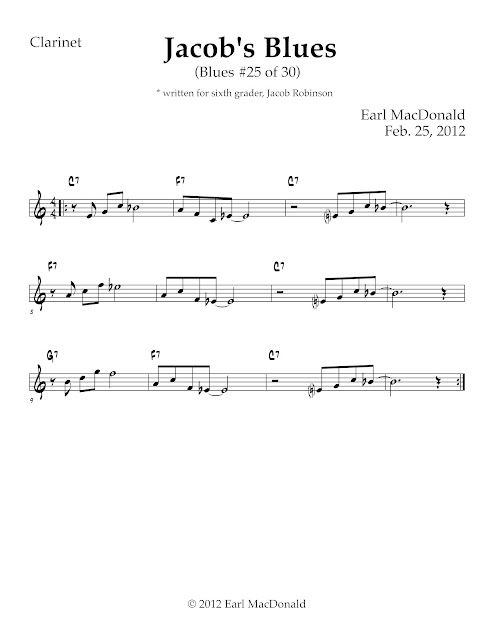Last month I posted a blog praising Chris Cheek's CD, "A Girl Named Joe". I continue to listen to this recording while running on the treadmill at the gym. The title track has really caught my attention and imagination. I love the slow, "triplet" 6/8 feel. The bluesy harmonic progression has elements of Hoagy Carmichael's "Georgia On My Mind". I decided to write a new melody over these chords. I retained the bass line, but ditched the bridge of the original song.
I think it is safe to call this piece a 24-bar blues, although not according to the traditional definition of doubling the blues' harmonic rhythm. Mark Gridley, the author of the "Jazz Styles" jazz history textbook defines a blues as "a piece characterized by one or any combination of the following: a) the I-IV-I-V-I chord progression or some variation of it in a 12-bar package, b) a sad feeling, c) a slow pace, d) poetry in the form of paired couplets in iambic pentameter, e) many lowered third, fifth, or seventh intervals." I've got "b", "c" and "e" covered.
This is song 29 of 30 in my self-imposed 30 day challenge. I've got just one more to go! What it will be, I do not know.
Because those last 2 sentences rhymed, maybe I'll try out some iambic pentameter in the spirit of Gridley's fourth definition. I guess we'll see...
I think it is safe to call this piece a 24-bar blues, although not according to the traditional definition of doubling the blues' harmonic rhythm. Mark Gridley, the author of the "Jazz Styles" jazz history textbook defines a blues as "a piece characterized by one or any combination of the following: a) the I-IV-I-V-I chord progression or some variation of it in a 12-bar package, b) a sad feeling, c) a slow pace, d) poetry in the form of paired couplets in iambic pentameter, e) many lowered third, fifth, or seventh intervals." I've got "b", "c" and "e" covered.
This is song 29 of 30 in my self-imposed 30 day challenge. I've got just one more to go! What it will be, I do not know.
Because those last 2 sentences rhymed, maybe I'll try out some iambic pentameter in the spirit of Gridley's fourth definition. I guess we'll see...







































